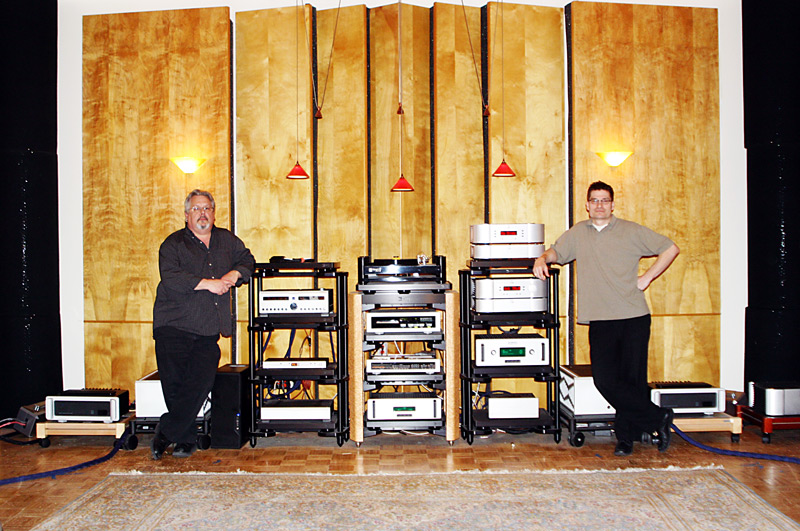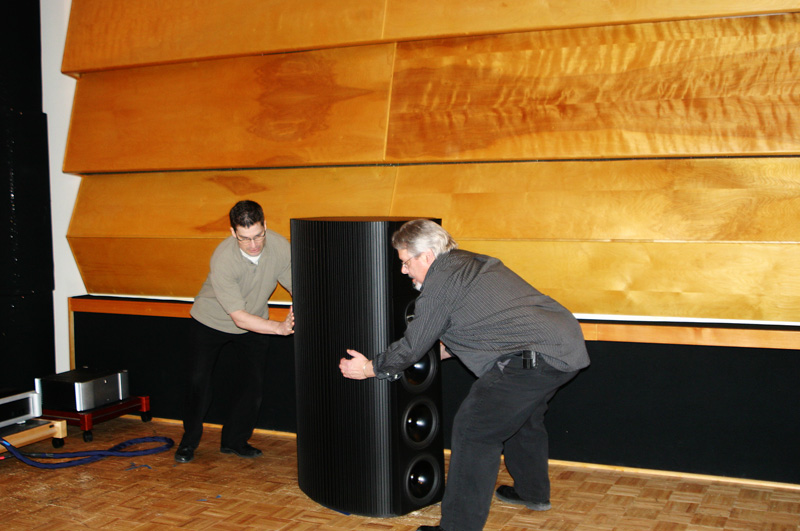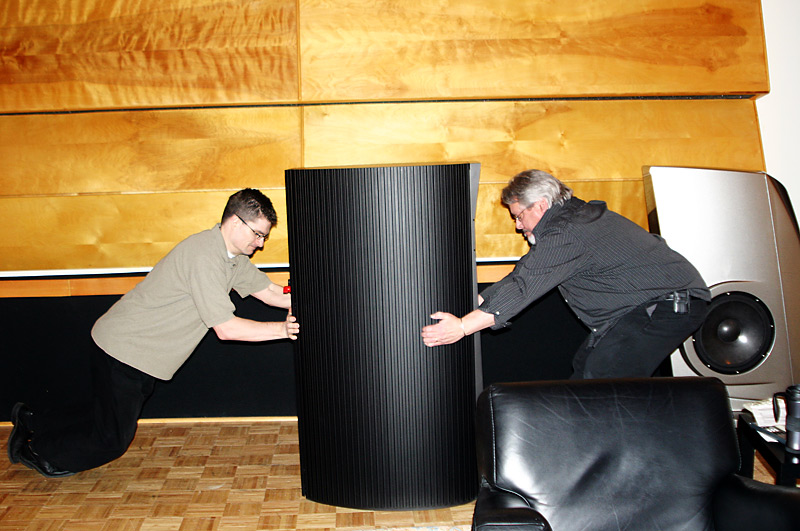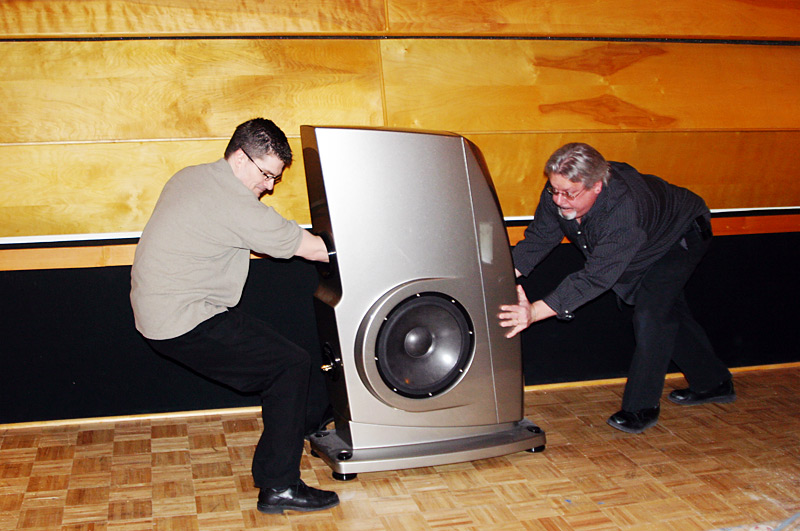| March 1, 2009
Goodwin's High End -- A Wonderland
While visiting Goodwin’s High End, in Waltham,
Massachusetts, just outside Boston, I realized that there is a disconnect between
reviewers and retailers of high-end audio equipment. It’s easy to see why: When you
write for a legitimate audio-review publication, your correspondence with manufacturers is
direct: review samples are procured straight from the companies themselves, and if you buy
a component, that’s handled directly too, via what’s called an "industry
accommodation purchase." My buying relationship with dealers was severed point-blank
over ten years ago, when I became a professional audio reviewer, though in those ten years
I’ve continued to visit many dealers.
It is the consumer who bridges the gap between dealers and
the press, and sometimes that gets forgotten. You know the drill: you read a glowing
review, locate a dealer that carries the product, and go there to audition it for
yourself. This makes the dealer happy, and if you are too, you just might fire off an
e-mail to let the reviewer know that he or she got it right. But as you well know, it
doesn’t always work like that. Some reviewers aren’t reliable purveyors of
information, and some dealers aren’t really equipped to demonstrate high-end audio
gear with the careful attention to detail required to make it perform at its best.
But those are the exceptions. The fellows who write for Ultra
Audio are pretty reliable in their opinions, and there are some terrific high-end
dealers out there. In this case the two came together, and I came away with a tremendous
respect for what is, in my opinion, one of the best high-end audio dealerships I’ve
ever visited.
Goodwin’s High End was founded in 1977 by Alan
Goodwin. Though they’ve moved several times over the years, Goodwin’s remains a
fixture in the Boston audio scene -- local audiophiles know this place well. And due to
the breadth of their product line, staff expertise, and terrific facilities, audiophiles
nationwide know Goodwin’s, too. That’s why I visited -- to see what all the fuss
was about.
Goodwin’s System Designer Paul Chambers was kind
enough to open the store’s doors an hour early for me and fellow SoundStage! Network
scribe Randall Smith. I’d called Chambers the week before because Randall and I would
be returning from a trip to Transparent Cable and Rockport Technologies, both based in
Maine, and from what I’d heard from a number of manufacturers, dropping by
Goodwin’s was a "must-do."

Paul Chambers (left) and Al Moulton
Randall and I arrived at 9:30 a.m., a half hour before our
scheduled appointment with Chambers. But it was really cold outside, particularly
for a couple of beachgoing North Carolinians, and we’d already spent almost an hour
warming the seats of a Dunkin Donuts. Chambers was kind enough to let us in, and in no
time we’d begun our tour.
Goodwin’s is divided by a central hallway, both sides
of which are lined with demo rooms. As Chambers guided us through the store, I was
instantly impressed by the brands I saw, many of them firms with which I’ve
established relationships over the years. Represented were, in some cases, the entire
product lines of companies from a list that reads like a Who’s Who of high-end
audio: Audio Research, Berkeley Audio Design, Boulder Amplifiers, Dynaudio, Magico, Nagra,
Nordost, Rockport Technologies, Shunyata Research, Simaudio, Spectral, Verity Audio, and
on and on. The breadth of selection was amazingly complete.

Push, Al, push!
As I quizzed Chambers, I became aware that this guy has
been around the high-end block more than a few times. He knows his stuff, and when he told
me he had 30 years of experience, I believed him. After a brief introduction to each room
and its high-end inhabitants, we made our way to the last room on the right, one that
I’m sure is well known to Boston-area audiophiles. The store’s proprietor, Alan
Goodwin, designed the room in 1995 with ample diffusion and minimal absorption -- somewhat
like my own Music Vault. Set up for us to listen to were the Magico M6 four-way
floorstander -- a 650-pound aluminum testament to designer Alon Wolf’s
no-holds-barred approach to his art. The speakers were tethered to an equally impressive
array of electronics: Boulder Amplifiers 2050 mono amps and a 2010 preamplifier, a
Berkeley Audio Design Alpha DAC, and a custom music server that Goodwin’s had built
(and which they can arrange for you to buy, though not for their own profit). For our demo
disc, a Spectral CD player was used. Chambers’s cohort in system design, Al Moulton,
joined us just before we got cranked up, and he proved to be equally helpful and
knowledgeable.
Chambers and Moulton did two things that impressed me
immensely. First, once he was confident that all was operating properly and that Randall
and I were comfortable, Chambers handed me the remote controls. He and Moulton then left
the room and let us have at it. Second, when the speaker switch was made (from Magico to
Rockport), Moulton sat down in the listening seat and, with an eagle eye, ensured that the
speakers’ toe-in angle was just perfect -- something I was going to do if he
hadn’t. In short, these guys understand high-end audio.
Immediately on hearing the Magico M6, I knew it possessed
some outstanding qualities. The sonic coherence of the outputs of drivers made of
very different materials was amazingly good: the AMT tweeter was perfectly integrated into
the entire sonic landscape, and the transition from crystal-clear highs to a spookily
clean midrange was seamless. What might have been the M6s’ overriding characteristic,
however, was their ability to precisely focus performers within the soundstage. These
speakers, for all their bulk, were nothing if not focused in a fashion normally heard only
from minimonitors. And the bass . . . well, it could certainly drive -- no, control
that large room with ease. Wow.

Just a little more!
Then Chambers and Moulton got the M6s out of the way, and
moved in the other large speakers that are on continual demo in that room: the Rockport
Technologies Altairs (Al demonstrates a maneuver in the accompanying photo that I
don’t recommend you try at home unless you’re a physician). The Altair is a
known quantity to me, having been my reference speaker for the past two years. But on this
day I discovered it anew in a space that, although acoustically different from the smaller
Music Vault, is capable of some of the best sound I’ve ever heard. The Altairs
instantly threw out a massive soundstage that engulfed the entire room. The
midrange was palpable and had singular clarity, and the entire frequency range was
reproduced with extreme neutrality. Again, wow.

I hope he doesn't want to switch back.
Whether we played our demo CD or tracks from Goodwin’s
music server, the acoustic nature of the listening room was simply extraordinary. As far
as I’m concerned, this facility is the place to audition high-end audio gear.
As we wrapped up the audition, I glanced down at my cell
phone and realized that we’d been at Goodwin’s for over two-and-a-half hours,
and needed to hit the road for the long trek back to North Carolina. But first, Al Moulton
gave us a ride to the train station so that we could pop into town for some of the best
pizza I’ve ever had: Umberto’s, in Boston’s North End. Over my fifth slice,
I looked up at Randall and chuckled: "I know people are going to expect a detailed
comparison of the Rockports and the Magicos, as those are two companies that are really
hitting on all cylinders right now. But wouldn’t it be better for Goodwin’s to
have people come in and actually hear them for themselves? That’s how I’m
going to end the article, giving just that piece of advice: Go hear ’em for
yourself!"
For more information, visit www.goodwinshighend.com.
. . . Jeff Fritz
jeff@ultraaudio.com
|